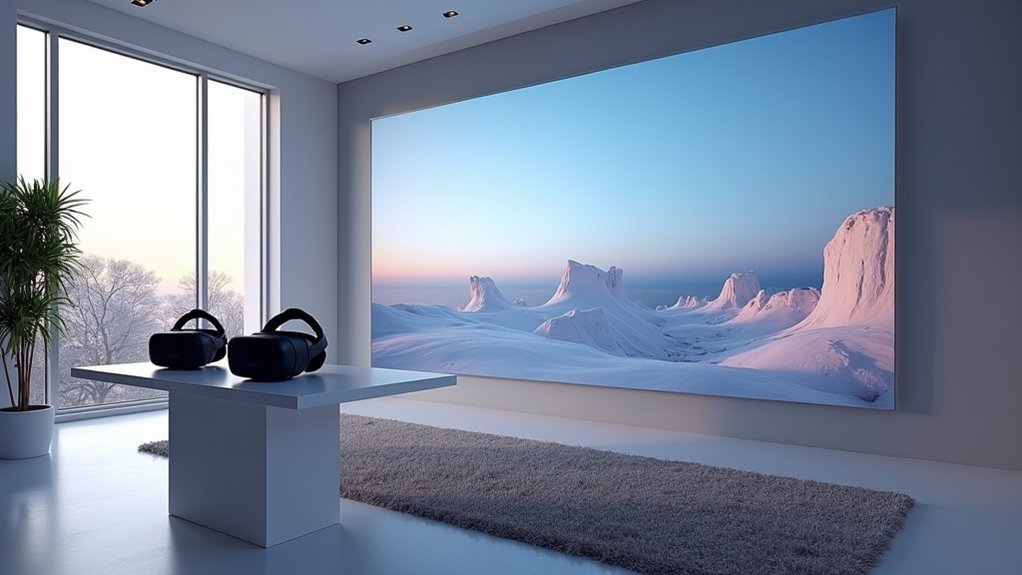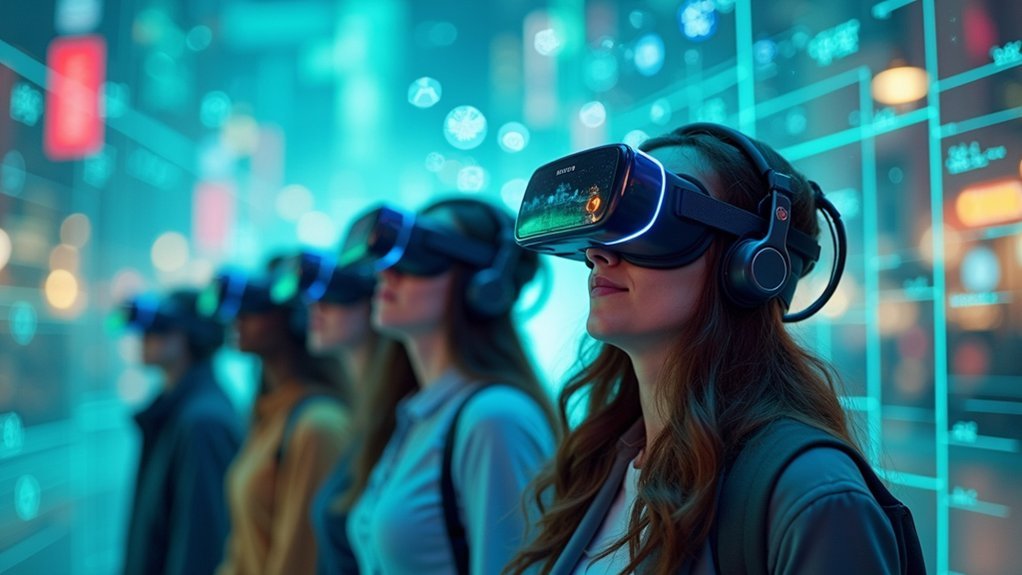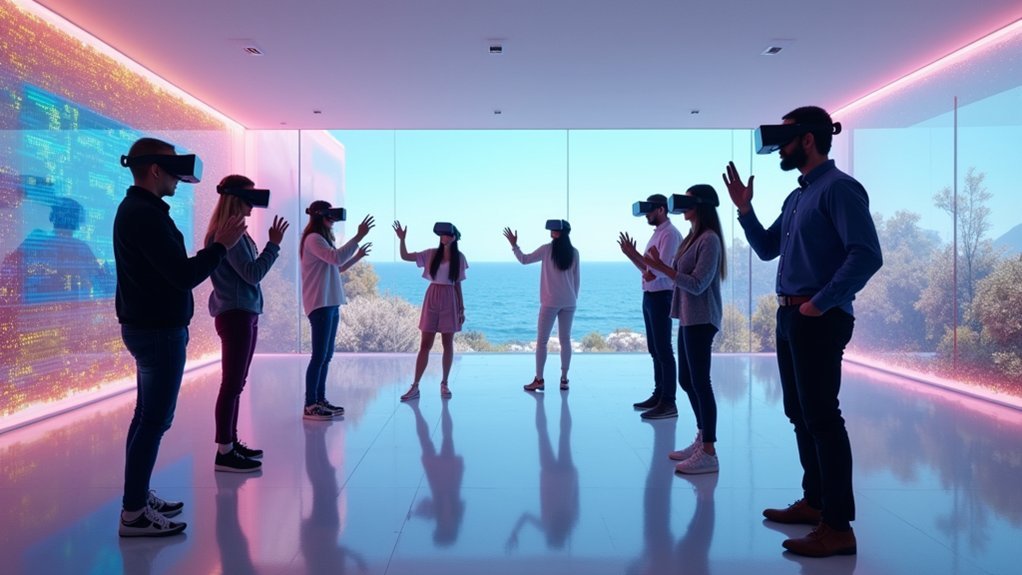You’ll need a minimum 10×10-foot space with 8-foot ceilings, soft flooring, and non-reflective surfaces for your shared VR setup. Install wireless headsets like Vive Pro with a high-end PC featuring GTX 1080 or better graphics. Position base stations at opposite corners, 6.5 feet high, angled downward for ideal tracking. Use modular walls for flexible boundaries and establish clear safety zones to prevent collisions. This guide covers everything you need to create your immersive multiplayer environment.
Space Requirements and Room Dimensions

When designing a shared VR space, you’ll need at least a 10-foot by 10-foot area to guarantee users can move freely without bumping into walls or each other. This minimum dimension accommodates natural movement patterns and interactive gestures essential for an immersive VR experience.
Your ceiling height must reach 8 feet minimum to prevent users from accidentally hitting overhead surfaces during gameplay.
Install soft flooring with at least 1-inch thickness to cushion potential falls and enhance safety in your shared space.
Consider modular walls for flexible boundary configurations, with round outer walls offering superior adaptability for different group sizes and activities.
Eliminate all reflective surfaces from your space, as mirrors and glossy materials interfere with tracking systems, causing movement detection inaccuracies that compromise the VR experience.
Hardware Selection for Multi-User VR
Although selecting the right hardware forms the foundation of any successful multi-user VR setup, you’ll need to prioritize processing power and wireless capabilities to accommodate multiple users simultaneously.
Your hardware selection should start with a high-end PC equipped with at least a GTX 1080 graphics card to guarantee smooth VR multiplayer performance across multiple headsets.
High-end PCs with GTX 1080 graphics cards form the backbone of seamless multi-headset VR experiences.
You’ll want to invest in wireless headsets like the Vive Pro to eliminate tethering risks and enhance user mobility throughout your shared space.
Don’t overlook tracking infrastructure—proper placement of tracking cameras prevents blind spots while overhead tether management systems avoid cable tangling if you’re mixing wired and wireless setups.
This combination creates an immersive, collision-free environment where multiple users can interact safely.
Tracking System Configuration
Once you’ve secured the right hardware, proper tracking system configuration becomes the backbone that determines whether your multi-user VR experience succeeds or fails.
Your Shared Spatial environment demands precise setup to maintain tracking accuracy across multiple users simultaneously.
Configure your tracking system using these critical steps:
- Position base stations strategically – Mount lighthouses at opposite corners, 6.5 feet high, angled downward to eliminate blind spots throughout your play area.
- Clear reflective surfaces – Remove mirrors, glossy screens, and metallic objects that interfere with tracking sensors, especially important for Meta Quest headsets using inside-out tracking.
- Implement cable management – Install overhead tether systems to keep wires organized and prevent tangling between multiple users moving within the same space.
Regular calibration guarantees consistent precision for immersive multi-user experiences.
Cable Management Solutions
When setting up your shared VR space, you’ll need to decide between wireless and wired headsets since each approach presents distinct cable management challenges.
Wireless headsets eliminate tethering cables entirely, giving users maximum freedom of movement without tripping hazards.
If you’re using wired systems, overhead cable routing through ceiling-mounted tracks or retractable systems keeps cables suspended above the play area, preventing tangles and maintaining clear floor space for multiple users.
Wireless Vs Wired
While wireless VR headsets offer unparalleled freedom of movement in shared spaces, you’ll need to weigh this advantage against the reliability and performance benefits that wired setups provide.
Wireless headsets eliminate tripping hazards and allow natural movement without cable restrictions. However, they may experience connectivity drops or battery limitations during extended sessions.
Wired configurations deliver consistent performance and unlimited playtime but require strategic cable management when multiple users share a space.
Consider these key factors when choosing between wireless and wired:
- Safety priorities – Wireless reduces collision risks, while wired needs overhead tether systems
- Performance requirements – Wired offers lower latency for demanding applications
- User capacity – Multiple wireless users move freely; wired setups need separate tracked areas
Regular maintenance guarantees peak performance regardless of your chosen configuration.
Overhead Cable Routing
Effective overhead cable routing transforms chaotic wired VR setups into organized, professional installations that maximize safety and performance.
You’ll need overhead tether management systems to keep cables organized and eliminate tripping hazards during VR experiences. Position tracking cameras strategically overhead to eliminate blind spots while ensuring extensive play area coverage.
Implement cable routing solutions like ceiling-mounted cable trays or conduits to maintain a clean, clutter-free environment.
Consider installing retractable cable reels that provide easy access while keeping cables out of the way when not in use. Regularly inspect and secure all cables to prevent wear and tear that could cause connectivity issues or session interruptions.
This systematic approach creates safer, more immersive experiences for multiple users.
Safety Considerations and Boundaries

Although virtual reality offers incredible immersive experiences, you’ll need to prioritize physical safety when designing your shared VR space. Proper safety considerations and boundaries protect users from injuries while maintaining immersion with game objects and virtual environments.
Essential safety features include:
- Minimum 8-foot ceiling height – This guarantees users can move their arms freely without hitting overhead obstacles during gameplay.
- Soft, modular walls and thick flooring – These materials cushion falls and protect both users and equipment from damage during active sessions.
- Non-reflective surfaces throughout – Avoiding mirrors and glossy materials prevents tracking interference that could cause disorientation or accidents.
Establish clear boundaries between multiple user areas to prevent collisions and cable entanglement.
Flexible wall systems allow you to reconfigure spaces as needed while maintaining safe separation zones for different activities.
Network Infrastructure Setup
You’ll need to establish a robust network foundation that can handle multiple VR users simultaneously without compromising performance.
Start by calculating your bandwidth requirements based on the number of concurrent users and their VR applications, then guarantee you have at least 25 Mbps download and upload speeds as your baseline.
Next, you’ll want to configure your router with Quality of Service settings that prioritize VR traffic over other network activities.
Bandwidth Requirements Planning
When setting up a shared VR space, bandwidth planning becomes the foundation that determines whether your virtual environment runs smoothly or suffers from frustrating interruptions.
Your bandwidth requirements directly impact user experience, making proper planning essential for success.
Essential Bandwidth Planning Steps:
- Calculate user capacity – Allocate 1-3 Mbps per simultaneous user, ensuring your total bandwidth exceeds peak usage demands for ideal VR performance.
- Establish minimum thresholds – Secure at least 25 Mbps baseline bandwidth to support multiple users without lag during critical interactions.
- Implement traffic prioritization – Configure Quality of Service (QoS) settings on your router to prioritize VR traffic over competing network activities.
Choose wired Ethernet connections over Wi-Fi whenever possible to reduce latency.
Regularly monitor network performance through speed tests to verify your shared VR environment maintains consistent, reliable connectivity.
Router Configuration Settings
Since your bandwidth planning establishes the foundation, your router configuration becomes the critical next layer that transforms raw internet speed into optimized VR performance.
Enable Quality of Service settings to prioritize VR devices over other network traffic, dramatically reducing latency during multiplayer sessions. Configure DHCP to assign static IP addresses to each headset, preventing connectivity drops when multiple users join simultaneously.
Create a dedicated 5GHz wireless network exclusively for your VR devices. This separation minimizes interference from smartphones, tablets, and smart home gadgets that compete for bandwidth.
Enable UPnP to streamline device connections and eliminate complex port forwarding setup.
Update your router firmware regularly to maintain security and compatibility with evolving VR applications.
These configuration tweaks guarantee your shared VR space delivers consistent, lag-free experiences for all participants.
Shared Spatial Anchoring Implementation
Although Shared Spatial Anchoring represents one of VR’s most exciting multiplayer features, implementing it on Meta Quest headsets requires specific setup steps to guarantee seamless collaboration.
Shared Spatial Anchoring delivers VR’s most compelling multiplayer capability, though proper Meta Quest configuration ensures optimal collaborative experiences.
This Mixed Reality technology transforms how you’ll interact with others in virtual environments by anchoring digital objects to real-world surfaces.
To enable Shared Spatial Anchoring with Passthrough, you’ll need to:
- Enable Passthrough in Quest menu settings and configure Boundary settings to outline your playspace
- Activate Space Setup to label tables and surfaces for accurate virtual object alignment
- Enable point cloud data sharing in Privacy Settings for multiple users to interact with shared virtual objects
Games like Demeo, Grokit, and Puzzling Places already support this feature, creating enhanced multiplayer experiences that make collaboration more immersive and engaging within shared physical spaces.
User Synchronization and Calibration
Before multiple users can share virtual objects in the same physical space, proper synchronization and calibration guarantees everyone sees and interacts with identical digital elements at precise real-world locations.
You’ll need compatible Meta Quest headsets for all participants to facilitate seamless interaction.
Start by enabling Passthrough in your Quest menu settings, then outline your playspace using Boundary settings for accurate environmental alignment.
During Space Setup, you’ll align virtual walls and anchors with real surfaces—make sure to label tables and surfaces for anchoring game objects.
Enable point cloud data sharing in Privacy Settings to allow precise spatial mapping across devices.
Follow us through consistent testing and adjustments, as environmental factors affect stability.
Our sample project demonstrates how proper calibration maintains synchronization throughout your shared VR experience.
Content Selection for Group Experiences
You’ll need to carefully choose content that maximizes engagement and collaboration among your group members.
Consider multiplayer games that support shared spatial anchoring, educational experiences that promote learning together, and collaborative design tools that let everyone contribute creatively.
Your content selection directly impacts how well participants can interact, communicate, and work together in the virtual environment.
Multiplayer Game Selection
How do you choose the right multiplayer games that’ll transform your shared VR space into an engaging collaborative environment? Start by prioritizing titles specifically designed for cooperative play. Demeo, Grokit, and Puzzling Places excel at utilizing spatial anchoring features while supporting seamless space resynchronization for multiple users.
Focus on three key criteria when selecting games:
- Augmented reality compatibility – Games like Demeo leverage your headset’s full immersive capabilities.
- Smooth interaction mechanics – Titles such as Grokit maintain fluid gameplay for multiple participants.
- Diverse engagement levels – Puzzling Places offers relaxing family-friendly experiences suitable for all skill levels.
Don’t overlook collaborative creation tools. Figmin XR and ShapesXR enable players to design and build together, fostering creativity and sustained engagement in your shared virtual environment.
Educational Content Types
Beyond entertainment-focused multiplayer experiences, educational VR content opens powerful opportunities for group learning that weren’t possible in traditional classroom settings.
You’ll want to prioritize interactive simulations like virtual science labs or historical recreations that let participants conduct experiments and explore events firsthand. These experiences notably boost engagement and knowledge retention.
Consider collaborative problem-solving activities such as virtual escape rooms or team challenges that develop communication and teamwork skills.
Immersive storytelling experiences work exceptionally well, allowing your group to explore narratives from multiple perspectives while building empathy around complex topics.
Choose content supporting diverse learning styles through visual, auditory, and kinesthetic elements.
Most importantly, select experiences with built-in assessment tools and feedback mechanisms so you can gauge understanding and adjust instruction to meet your group’s specific needs effectively.
Collaborative Design Tools
When selecting collaborative design tools for your shared VR space, focus on platforms that enable real-time co-creation and manipulation of virtual objects. Tools like ShapesXR and Figmin XR allow multiple users to simultaneously create and modify designs, fostering dynamic group collaboration.
Consider these essential elements for effective collaborative design:
- Real-time interaction capabilities – Choose tools that support multiple users manipulating objects simultaneously without lag.
- Cooperative gameplay options – Games like Demeo and Puzzling Places promote teamwork through shared virtual element interaction.
- Developer-friendly frameworks – Utilize resources like SharedSpaces sample and Unity’s Asset Store to streamline prototyping.
Remember to properly align your physical and virtual spaces using tools like Space Setup. This guarantees seamless interaction with collaborative design platforms, maximizing your team’s creative potential in the shared environment.
Performance Optimization Techniques
Although shared VR experiences deliver incredible immersion, they’ll only reach their full capacity when your system runs at peak performance.
You’ll need a high-end PC with a powerful GPU like the GTX 1080 or better to handle demanding graphics and processing requirements smoothly. Make certain your environment’s well-lit for accurate tracking, since poor lighting causes decreased performance and tracking failures.
Keep your VR software and drivers updated regularly to incorporate performance enhancements and bug fixes that improve system stability and responsiveness.
Implement smart cable management solutions such as overhead tethers and wireless headsets to minimize latency and physical interference.
Design your playspace with appropriate boundaries and adequate room to prevent collisions while making sure tracking systems function effectively without obstructions affecting user experience.
Troubleshooting Common Issues
Even with ideal performance settings, shared VR experiences can present frustrating technical challenges that disrupt your immersion.
You’ll likely encounter several recurring issues that can derail your collaborative sessions.
The most common problems include:
- Black screen with controller instructions – This typically indicates entitlement issues in your App Lab version that prevent proper environment loading.
- Host navigation failures – Shifting from transition maps to lobby maps often breaks, requiring clearer protocols or immediate bug fixes.
- Inconsistent cross-device experiences – Different account types (test versus regular accounts) create varying functionality levels across users.
You should implement entitlement checks in your sample projects to resolve login issues and guarantee proper online feature access.
While recent updates have improved functionality for some users, ongoing feedback remains essential for addressing lingering issues, particularly with map shifts.
Maintenance and Updates
Since your shared VR environment operates as a complex ecosystem of hardware and software components, you’ll need to establish a consistent maintenance routine to prevent technical degradation.
Regularly check for software updates across your VR platform, as these improvements enhance functionality and resolve bugs affecting shared spatial anchoring and multiplayer experiences.
Software updates are essential for maintaining optimal VR functionality and preventing bugs in shared virtual experiences.
Maintain your hardware by cleaning lenses, keeping tracking cameras unobstructed, and updating drivers to optimize performance and prevent connectivity issues.
Schedule periodic testing sessions with users to identify inconsistencies or problems within the shared environment, ensuring smooth immersive experiences.
Document all changes and updates to your setup or software—this tracking helps monitor improvements and address recurring issues effectively.
Engage with community forums and social media channels to stay informed about emerging problems and collaborative troubleshooting solutions.
Frequently Asked Questions
How to Make Space for VR?
You’ll need at least 8-foot ceilings for arm movement. Install soft, modular walls to define boundaries. Use thick flooring for safety. Avoid reflective surfaces that interfere with tracking. Consider overhead cable management systems.
What Is the VR Game Where You Build Stuff?
You’ll find several VR building games like ShapesXR for collaborative design, Figmin XR for creating virtual artwork, Puzzling Places for jigsaw puzzles, and Demeo for strategic tabletop experiences with friends.
Is VR Spacewalk Free?
Yes, you’ll find VR Spacewalk is completely free on the Meta Quest platform. You don’t need any purchase or subscription fees to explore space and interact with celestial bodies in this immersive experience.
Can Two People Play VR in the Same Room?
You can play VR with another person in the same room using compatible headsets with shared spatial anchoring. You’ll need proper room setup, passthrough enabled, and multiplayer games like Demeo or Grokit.
In Summary
You’ve now got everything you need to create an incredible shared VR space. Remember that building a multi-user setup takes patience and experimentation—don’t expect perfection on day one. Start with basic configurations and gradually add complexity as you become more comfortable. Keep your hardware updated, maintain clear safety protocols, and always prioritize user comfort. With proper planning and execution, you’ll deliver unforgettable virtual experiences that’ll keep everyone coming back for more.





Leave a Reply